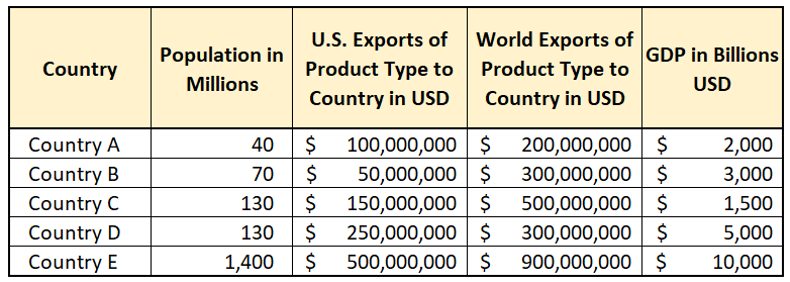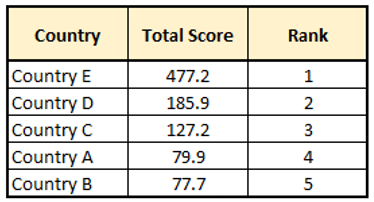Your company is ready to enter or expand its international sales and needs to choose the appropriate markets. Where do you start? Conforming to a well-defined process will help your company identify which markets provide the best conditions for its product or service. The following method can help build the process to choose the right markets for your company.
Start with a group of countries that your company might be considering for your exporting business. Now it is time to assess each country and rank them based on the factors most important to your company.
Step 1 – Choose your indicators
Theses could be based on your company’s product, industry, the market, or other factors. Here are a few indicators you might consider:
- Population
- Value in USD of your company’s product type (use harmonized code) exports from the United States
- Value in USD of your company’s product type (use harmonized code) export from all countries
- Gross Domestic Product (GDP)

Step 2 – Rescale the indicators so they can be compared
Comparing different indicators that are measured in different ways can be challenging, it’s like comparing apples and oranges. Rescaling these pieces of data converts the measurements into scores on the same scale. Now with common measurements, we can start to compare our apples and oranges.
Here are the assumptions for our example:
- The most populated country has 1.4 billon people
- The least populated country has 800 people
- The most U.S. exports of your product type to a country is $700 million
- The least U.S. exports of your product type to a country is $100,000
- The most world exports of your product type to a country is $5 billion
- The least world exports of your product type to a country is $200,000
- Highest GDP = $22 trillion
- Lowest GDP = $288 million
In the following formula (learn more about the formula), a country’s GDP is converted from a dollar amount to a score on a scale of 1-100
GDP score = ((country GDP – lowest GDP)/(highest GDP – lowest GDP)) *100
This formula can be used to convert each indicator from different measurements and scales to a score based on a standard scale.
Below we have converted all our measurements into our normalized 100 point scale using the formula above.

Step 3 – Weight the indicators
All indicators are not created equal, and this is where your company needs to choose how the indicators relate to one another by their level of importance. How a company weights an indicator is unique. What is critical to your company may be less important to another. If indicators are not weighted appropriately, the country ranking is likely to be inaccurate.
In the example below, GDP is given twice the value of population based on the belief that having a higher GDP is more important than a larger population. These weights are chosen based on what is most important to your company.

Step 4 – Rank the countries
Once the scores are calculated, it is a simple matter of ranking them by highest to lowest score. Below we can see that country E with a score of 477.2 ranked highest.

Step 5 – Analyze the top ranked countries
This is where your company uses additional quantitative and qualitative factors to finalize a market choice. Just because a country scored the highest in our ranking does not mean that it is the right market for your company. There may be additional elements that make a particular country less attractive. Does the U.S. have a trade agreement in place? Is the country’s government stable? Are there restrictions or regulations that could be burdensome? What about the cultural aspects of doing business there? Is proximity an issue making shipping or travel overly difficult or expensive?
This process can be helpful in narrowing down your top foreign market choices, but there may be additional factors that make one country a clear winner which are unique to your company.
Whether you are currently exporting or just thinking about it, the Export-Import Bank of the United States (EXIM) has trade finance products designed to minimize the risk of foreign buyer nonpayment and access vital working capital. Free consultations are available to learn how EXIM can enable your company to grow its international sales.
